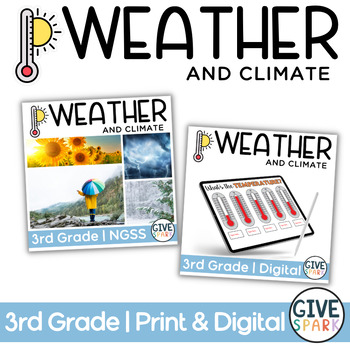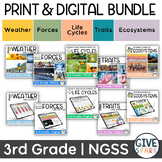PRINT and DIGITAL - Weather and Climate - Third Grade Science - NGSS Aligned
- Zip
- Google Apps™

What educators are saying
Products in this Bundle (2)
Also included in
- Third Grade NGSS: The Ultimate Teaching Bundle – Print & Digital!Get ready for an exciting science journey with this all-in-one bundle, perfect for third-grade teachers. This package includes FIVE highly engaging science units, all aligned with the NGSS standards. In this package, you will receiPrice $110.00Original Price $144.75Save $34.75
Description
PRINT and DIGITAL - Weather and Climate - Third Grade Science Unit - NGSS Aligned
This comprehensive bundle unit is specifically designed for third-grade students to learn about the topic of Weather and Climate.
STANDARDS ALIGNMENT:
The unit consists of 10 engaging lessons that incorporate hands-on activities. It is fully aligned with the Next Generation Science Standards (NGSS) for third grade, specifically covering the following standards: NGSS.3-ESS3-1 | NGSS.3-ESS2-1 | NGSS.3-ESS2-2
PRINT AND DIGITAL FORMATS:
Enjoy flexibility, with all activities available in both print and digital versions. The digital version is hosted on Google Slides and comes with options such as narrated audio lessons, video science lab demonstrations, and other activities allowing for easier differentiation and self-paced student learning.
APPROACH TO LEARNING
Unlock your students' natural curiosity and passion for science with this interactive and hands-on teaching unit. Designed to connect with their prior knowledge and provide immersive experiences, this unit offers lessons that guide students through complex scientific principles in an accessible way. Students will actively participate in hands-on experiments and activities that make learning exciting and memorable. This unit promotes independent learning and encourages students to reflect on their understanding, helping them build a solid foundation of knowledge in a fun and stimulating environment.
What's covered?
In this unit we look at the following topics:
- Lesson 1 - What is weather?
- Lesson 2 - How do we measure weather?
- Lesson 3 - What are the seasons and why do we have them?
- Lesson 4 - How do we measure temperature?
- Lesson 5 - Why is there water in the air?
- Lesson 6 - How does the sun’s energy affect the earth’s temperature?
- Lesson 7 - What is wind?
- Lesson 8 - What is a climate?
- Lesson 9 - How does extreme weather occur?
- Lesson 10 - How does extreme weather affect people?
Please preview BOTH products before purchasing.
Thank you for stopping by!





